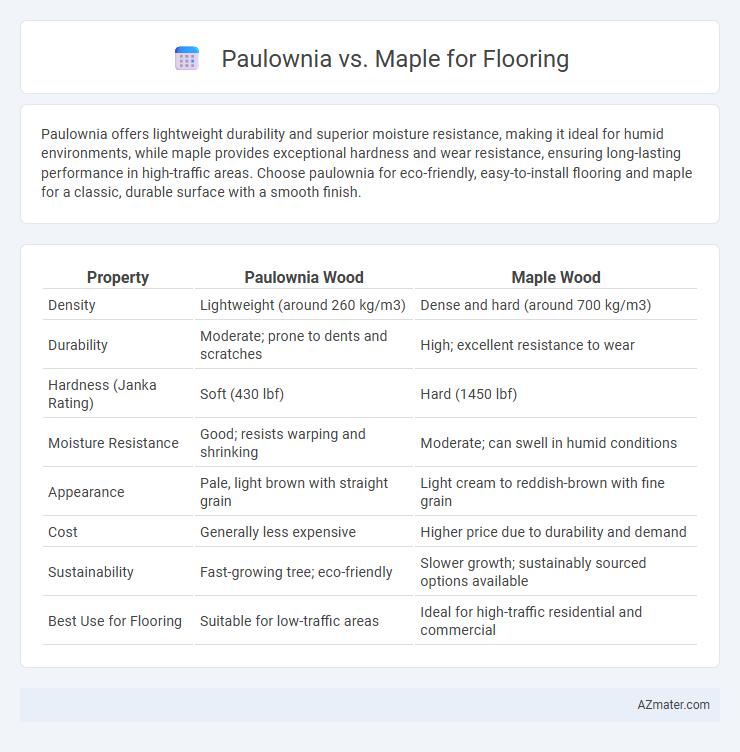Paulownia offers lightweight durability and superior moisture resistance, making it ideal for humid environments, while maple provides exceptional hardness and wear resistance, ensuring long-lasting performance in high-traffic areas. Choose paulownia for eco-friendly, easy-to-install flooring and maple for a classic, durable surface with a smooth finish.
Table of Comparison
| Property | Paulownia Wood | Maple Wood |
|---|---|---|
| Density | Lightweight (around 260 kg/m3) | Dense and hard (around 700 kg/m3) |
| Durability | Moderate; prone to dents and scratches | High; excellent resistance to wear |
| Hardness (Janka Rating) | Soft (430 lbf) | Hard (1450 lbf) |
| Moisture Resistance | Good; resists warping and shrinking | Moderate; can swell in humid conditions |
| Appearance | Pale, light brown with straight grain | Light cream to reddish-brown with fine grain |
| Cost | Generally less expensive | Higher price due to durability and demand |
| Sustainability | Fast-growing tree; eco-friendly | Slower growth; sustainably sourced options available |
| Best Use for Flooring | Suitable for low-traffic areas | Ideal for high-traffic residential and commercial |
Introduction to Paulownia and Maple Flooring
Paulownia flooring is prized for its lightweight, fast-growing timber with exceptional moisture resistance and dimensional stability, making it ideal for humid environments. Maple flooring offers a dense, hard surface with fine, consistent grain patterns, providing durability and classic appeal in high-traffic areas. Both woods vary significantly in hardness and appearance, influencing their suitability for different flooring applications and design preferences.
Wood Characteristics: Paulownia vs Maple
Paulownia wood features a lightweight structure with a straight grain and pale color, offering excellent dimensional stability and resistance to warping, ideal for eco-friendly flooring solutions. Maple, known for its hardness and fine, consistent grain, provides high durability and scratch resistance, making it suitable for high-traffic flooring areas. Both woods differ significantly in density and hardness, with maple being denser and harder, while paulownia is lighter and more flexible, affecting overall floor performance and maintenance.
Durability and Hardness Comparison
Paulownia wood is significantly lighter and softer than maple, with a Janka hardness rating around 330 psi compared to maple's robust 1,450 psi, making maple far more durable and resistant to dents and wear in flooring applications. Maple's tight grain pattern and high density contribute to its superior hardness, which is ideal for high-traffic areas, while Paulownia's softness makes it more susceptible to scratches and dents. For flooring requiring long-lasting durability and resistance to heavy use, maple is the preferred option over the lightweight and less resilient paulownia.
Aesthetic Appeal and Grain Patterns
Paulownia flooring boasts a light, creamy color with subtle, straight grain patterns that create a sleek, modern aesthetic, ideal for minimalist interior designs. Maple flooring features a fine, uniform grain with subtle variations and occasional birdseye or curly patterns, offering a warm, classic look suitable for traditional or contemporary spaces. Both woods provide distinct visual textures, with Paulownia's smooth surface enhancing brightness and Maple's intricate grain adding depth and character to flooring designs.
Installation Process Differences
Paulownia flooring offers a lightweight and softer material that simplifies cutting and nailing, making installation faster and easier compared to denser maple wood. Maple's hardness requires more robust tools and careful handling to avoid splitting, extending installation time and effort. Both materials demand proper subfloor preparation, but Paulownia's flexibility reduces the risk of cracking during installation.
Maintenance and Care Requirements
Paulownia flooring requires minimal maintenance due to its natural resistance to moisture and pests, making it ideal for low-humidity environments. Maple flooring demands regular sealing and refinishing to protect against scratches, stains, and wear, especially in high-traffic areas. Both woods benefit from routine cleaning with a damp mop and avoidance of harsh chemicals to maintain their durability and appearance.
Cost Analysis: Paulownia vs Maple Flooring
Paulownia flooring typically costs less per square foot compared to maple, making it an economical choice for budget-conscious projects. Maple flooring, known for its durability and hardwood density, commands higher prices but offers longer lifespan and better wear resistance. When evaluating cost analysis, initial expenses for paulownia are lower, but maintenance and potential replacement costs may increase over time compared to maple's more robust performance.
Environmental Impact and Sustainability
Paulownia flooring offers a significantly lower environmental impact due to the tree's rapid growth rate, high carbon sequestration ability, and minimal pesticide requirements compared to maple. Maple flooring, while durable, demands longer cultivation periods and often involves intensive forestry practices that can contribute to deforestation and reduced biodiversity. Choosing Paulownia supports sustainable forestry by promoting fast-renewing resources and reducing carbon footprints in flooring production.
Usage Suitability: Best Applications
Paulownia wood offers lightweight and moisture-resistant properties, making it ideal for areas with high humidity or where durability without heavy wear resistance is needed, such as bedroom flooring or decorative paneling. Maple presents superior hardness, scratch resistance, and durability, making it best suited for high-traffic spaces like kitchens, living rooms, and commercial flooring. Choosing between Paulownia and Maple depends primarily on the balance between desired hardness, moisture conditions, and the specific wear requirements of the flooring application.
Final Verdict: Which Flooring to Choose?
Paulownia flooring offers lightweight durability and excellent resistance to warping, making it ideal for climates with humidity fluctuations, while maple flooring provides superior hardness and a classic, dense grain pattern favored for high-traffic areas. Choosing between Paulownia and maple ultimately depends on balancing durability requirements with aesthetic preferences; maple is better suited for heavy-use spaces due to its hardness rating around 1450 on the Janka scale, whereas Paulownia, with a Janka rating near 540, excels in applications where lightweight and stability are priorities. For long-term investment and scratch resistance, maple flooring is the preferred choice, but Paulownia is advantageous for eco-friendly, sustainable projects and environments needing dimensional stability.

Infographic: Paulownia vs Maple for Flooring
 azmater.com
azmater.com